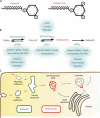Endosomal phosphoinositides and human diseases
- PMID: 18429927
- PMCID: PMC2607523
- DOI: 10.1111/j.1600-0854.2008.00754.x
Endosomal phosphoinositides and human diseases
Abstract
Phosphoinositides (PIs) are lipid second messengers implicated in signal transduction and membrane trafficking. Seven distinct PIs can be synthesized by phosphorylation of the inositol ring of phosphatidylinositol (PtdIns), and their metabolism is accurately regulated by PI kinases and phosphatases. Two of the PIs, PtdIns3P and PtdIns(3,5)P(2), are present on intracellular endosomal compartments, and several studies suggest that they have a role in membrane remodeling and trafficking. We refer to them as 'endosomal PIs'. An increasing number of human genetic diseases including myopathy and neuropathies are associated to mutations in enzymes regulating the turnover of these endosomal PIs. The PtdIns3P and PtdIns(3,5)P(2) 3-phosphatase myotubularin gene is mutated in X-linked centronuclear myopathy, whereas its homologs MTMR2 and MTMR13 and the PtdIns(3,5)P(2) 5-phosphatase SAC3/FIG4 are implicated in Charcot-Marie-Tooth peripheral neuropathies. Mutations in the gene encoding the PtdIns3P 5-kinase PIP5K3/PIKfyve have been found in patients affected with François-Neetens fleck corneal dystrophy. This review presents the roles of the endosomal PIs and their regulators and proposes defects of membrane remodeling as a common pathological mechanism for the corresponding diseases.
Figures

References
Publication types
MeSH terms
Substances
LinkOut - more resources
Full Text Sources
Other Literature Sources
Medical
Research Materials
Miscellaneous

